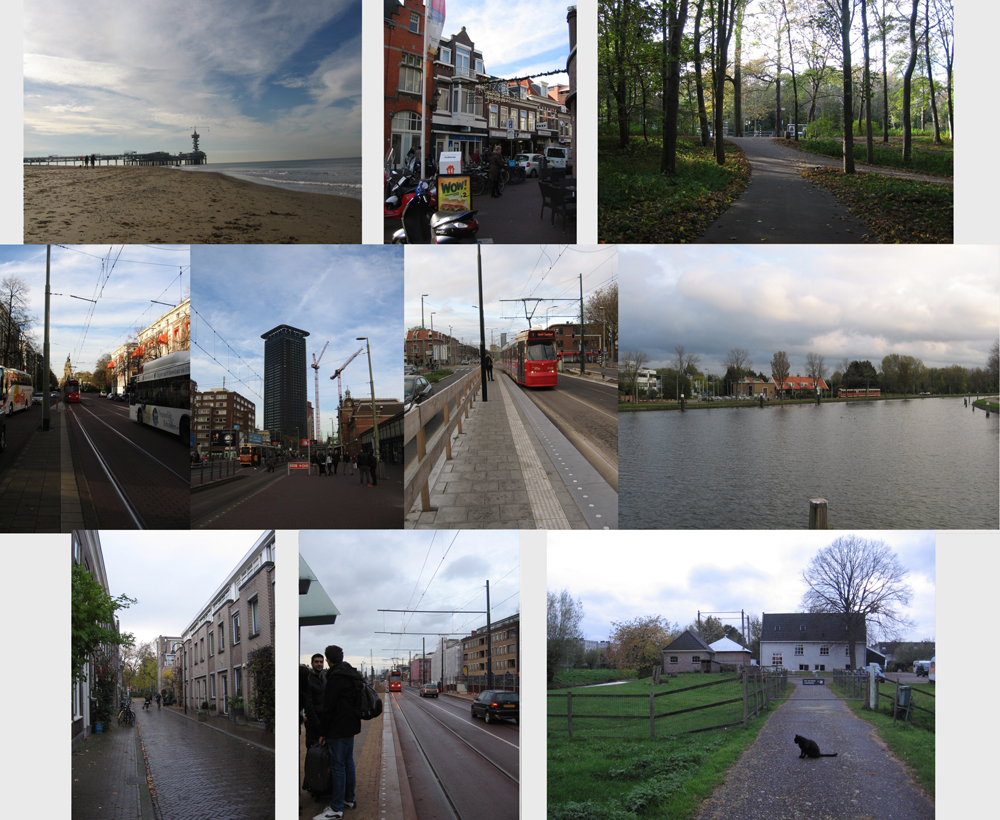
Podcast: Play in new window | Download (Duration: 57:00 — 133.6MB)
Subscribe: RSS
This edition of framework:afield has been produced by students of the University of the Arts, The Hage, in conjunction with Raviv Ganchrow’s Aural Tectonics seminar at the Institute of Sonology.
Tramway, 00:55:00, Two channel audio
The following piece is the outcome of an intensive exploration of Den Haag’s tramway. This expansive public transport network, crisscrossing the Dutch administrative capital, constitutes a site where distinctive trolley acoustics cross-fade with every-day rituals, subjective experiences and abstract temporalities. Taking the tram as a ‘site’ rather than merely a sounding object, permits an exploration of the various realms in which this specific form of transport is invested. Each of the eleven contributions, in this fifty-five minute sequence, explore a dedicated context of tramway audibility by developing diverse strategies of recording, editing, audio tweaking as well as sonic intervention. The result is a journey through various manifestations of the Den Haag tramway. From textural and rhythmic studies; to spatiotemporal and psychogeographic mappings; to social contexts and imaginary narratives; the tram is guided along diverse realities that are none the less firmly set in audible tracks.
The Aural Tectonics seminar at the Institute of Sonology explores site-specificity and context-dependency of sound by fostering a critical awareness of, and attitude towards, environmental ambiance. Founded in a practice-based approach, the seminar develops site-dependent strategies for listening, recording, mapping, synthesis and sound intervention. Each year a particular location is chosen around which a sequence of intensive projects are developed. Within that framework, alternative approaches to ‘hearing place’ are fostered by adopting locational modes of listening and encouraging personal approaches to contextual ambiance.
Participants:
Ruben Brovida, Izabel Caligiore, Kyriakos Charalampides, Colin Frank, Michael Huntington, Ernestas Kausylas, Matús Kobolka, Martin Ozwold, Julius Raškevičius, Stefano Sgarbi, James Wingard, Louise Wilson
Audio Mastering:
Ruben Brovida / Stefano Sgarbi
The Institute of Sonology website:
http://www.sonology.org
[time / artist / title / description]
///////////////////////////////// 00:01:25
/////// Kyriakos Charalampides
Tram3_DH_Rhythmanalysis
tram 3 route from Den Haag Central Station to Fahrenheitstraat
An individual’s daily routine is defined by the need of production. The production chain requires from the individuals to present themselves in a variety of places on the same day. This requirement creates the need for transportation. DH tram describes interrelationships between the motion of individuals and the production rhythms of The Hague. The DH tram, as the production process, is characterized by a cyclical rhythm. This rhythm originates from the linear nature of every tram route in The Hague. The bus stops, the amplified announcements and traffic lights define this rhythm and produce a daily timetable that describe the individual’s repetition and transportation routine. The interrelationship between The Hague citizens and DH tram expresses itself in a variety of ways. People face their presence on the tram as an every day ritual. They declare their presence through the automated check-in process and they find their own place in the space by assimilating themselves to the tram environment. They speak on their phones or listen to music in order to satisfy this daily tram ritual. This bidirectional connection between tram and the people is also revealed in the sonic environment of the tram. Passengers’ body rhythms are synchronized with the tram’s mechanical rhythms as a part of the assimilation process. Through this process the tram satisfies the individual’s expectations by creating eurythmic patterns. But if the tram rhythm disappoints the individual, an arrhythmic pattern reveals itself as an expression of this pathogenic situation. These patterns are audible. The polyrhythmic nature between engine noise and a phone conversation, as the rhythmic relationship between automated check-in tones and footsteps, are plainly audible. Those factual patterns are open to observation. This project aims to grasp the shifting, yet determinate, complexity of these interrelationship through sonic Rhythmanalysis.
///////////////////////////////// 00:05:03
////// Michael Huntington
Shift
Our perceived sonic environment is a product of a constrained sensory system governed by chemical reactions, necessity and evolutionary development. The deployment of novel miking techniques and extreme amplification allows us the opportunity to expand and extend our listening ear and thence ‘experience’ hitherto unknowable aural spheres. The speed of sound in air is ~5% its equivalent speed in steel tram rails. The tram-rail-network then, experiences a different and considerably more immediate sonic reality than we, but to what extent can this perspective shift be realised and truly experienced? Using only recordings derived from the rails themselves, my aim was to inhabit and explore the (possible) tympanic gulf between ear and steel and to examine our capacity to temporarily exist in an alien environment, with alien ears.

///////////////////////////////// 00:10:05
/////// James Wingard
From Beauty Corner to HS
Through habitual travel, otherwise passive commuters come to internalise sets of auditory cues arising directly from the motions of their chosen machines of public transportation. These cues become important markers, situating the traveller instantly without the aid of other senses, whilst other auditory information loses its importance, becoming interference, despite its potential value. This piece is an attempt at exploring that relationship between commuter and means of transportation developed over many journeys along a short section of the Den Haag tram network.
///////////////////////////////// 00:14:20
////// Louise Wilson
Bide Your Time
As part of my contribution to our Den Haag tram project I chose to focus on the moment of ‘waiting’ which is so ingrained in the culture of a public transport system user. The public transport system of any city, I find, is a meaningful way to get to know your surroundings. Listening to the dialogues of fellow passengers, watching the movements of people, and passing through areas you might not otherwise, deepen your understanding and enhance your experience of the environment.
Waiting is often one of my favourite aspects of travelling, I enjoy watching the scenery roll by, dipping in and out of my book, people watching, and day dreaming. Unforeseen, unexplained waiting is, however, the worst. When you can longer relax and enjoy your waiting, as those around you get more and more uneasy, waiting becomes a chore.
Den Haag acts as the seat of the Dutch Government and is home to many international institutions, for example the International Tribunal for the Formal Yugoslavia and the Organisation for the Prohibition of Chemical Weapons. For these, perhaps naive reasons, I expected upon moving here to find myself in a bustling city centre. I discovered the opposite, Den Haag gives grand illusions on an internet image search with its pseudo skyscrapers, but in reality it is a very calm, and relaxed town.
My input to our radio piece is four minutes and thirty seconds of an amalgamation of sounds which can be heard whilst waiting on a tram in Den Haag.
///////////////////////////////// 00:18:47
////// Ernestas Kausylas
Tram Gap
///////////////////////////////// 00:23:17
/////// Izabel Caligiore
Untitled
My piece is divided into four sections that interplay with the idea of the tram as a site. The voice becomes the basis of each narrative which develops from the motif, morphing throughout. The ambiguity between the imagined space and the synthesised or recorded sounds creates temporal and spatial shifts, analogous to the experience of detachment. The sound of an acoustic space, albeit simulated, is established, but then subverted; and the listener enters another space.
///////////////////////////////// 00:28:15
/////// Martin Ozwold
Untitled
///////////////////////////////// 00:33:12
////// Julius Raškevičius
Interference of Thought
A ride on Tram line #3 takes me on an daily trip between Grotemarktstraat and Heliotrooplaan in The Hague. Interference of Thought is a reconstruction of a first person experience of that ride: continuous from an observers perspective, but disjointed in terms of what is heard, seen or thought. The key process in the unfolding of this personal story is attention: divided or simultaneous, often uncontrollable, it cuts out and highlights the events which are experienced subjectively.
Trams offer a unique setting to observe the division between auditory, visual and tactile perceptions. As I sit browsing my smartphone or observing the passing streets and canals outside, the visual domain gets mixed with the auditory domain of the moving, working machine. Noises of the tram interject into my experience of virtual world of the internet, cutting through it and disrupting my concentration. The opposite is also true – the flow of banners, text and images molds the ambient sound, masking the voices and altering the metal grinding sounds of the tram.
///////////////////////////////// 00:38:13
////// Ruben Brovida and Stefano Sgarbi
Intramezzo
This piece employs the tram as a musical score for voice. The piece was performed live at the Den Haag Hollands Spoor tram station with a vocal ensemble of three to four people. This stop, close by a busy railway station, is a location where numerous parallel tram lines converge. The presence of the tram triggers the singing and its approach and departure works as an envelope guide for the amplitude (level) of the singing. Waiting time between consecutive trams in the schedule determines the timing of the events. The recording strategy utilizes various microphone techniques: binaural, shotgun and XY. Different sonic perspectives of the event are captured simultaneously and brought together, compositionally, later in the editing process. As an artistic act we take to the street, singing in a place that facilitates inner-urban movement where people are mostly focused on their daily habits, and in doing so we offer a non-moment of stillness.
Voices and supporters:
Sheyda Dashti, Joan Mena, Malgorzata Kozlowska, Yoram Grau
///////////////////////////////// 00:47:17
////// Colin Frank
Interior-Exterior Spaces Along Tram Line 1 (Scheveningen, Den Haag – to – Tanthof, Delft)
This study focuses on the discontinuity between the tram’s inside verses the outdoor space it traverses. The interior of a tram contrasts with the landscape it passes through: inside people are stationary and passive, encapsulated by the squealing, rattling, and heat of the machinery; while the exterior world exists primarily as images for the traveller, bearing little if any visceral connection, and providing a continuous stream of varying spaces.
I attempted to emphasize this relationship by studying a selection of stops along The Hague’s tram #1 line. As I travelled from Scheveningen to Delft I would hop off the tram, record the area within walking distance, then catch the next tram 10 minutes later. The data collected was then edited in a manner that juxtaposes the sounds at each stop against an amplified image of the tram’s interior. To ensure the montage emulates the line’s length, I spliced the sound files together proportional to the total distance, and condensed the one hour ride into 6 minutes of audio.

///////////////////////////////// 00:53:20
/////// Matúš Kobolka
Great Meals On Wheels